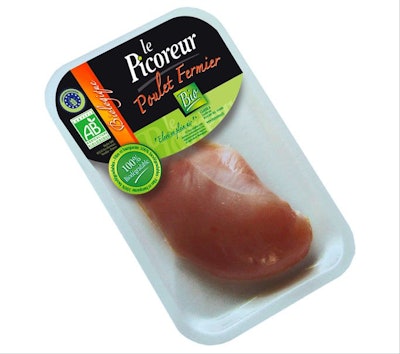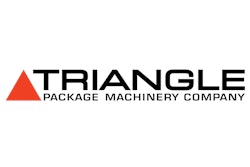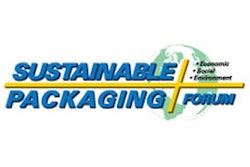
In short order, polylactic acid (PLA) has gone from obscurity to the
most commercialized of the alternatives to petroleum-based plastics.
Since sustainability concerns profits, planet, and people, it’s to be
expected that a brand-owner would promote its choice of PLA. And,
although promotional claims originate at the resin supplier, it’s the
responsibility of the brand-owner to decide how to promote to the
consumer.
Renewable is the overall best claim.
Renewable is the one claim that’s unconditional, since PLA is sourced from plants. Renewable hits directly at a core objective of sustainability: reducing the use of fossil fuels. Renewable need not be the only promotional claim that the brand-owner places on its PLA packaging, but it should always be one of them.
But, how, exactly, should renewable be communicated? The word alone could lend itself to various interpretations; therefore, context is important. Naming the renewable source makes good sense, for example: Made 100% from corn, a renewable resource; the idea is conveyed even without the phrase, a renewable resource. In the case of multiple components, it’s best to specify what’s being referred to, for example, Tray made 100%...
There is packaging currently on market shelves that identifies the PLA by brand name, followed by the description, Plastic from nature. It’s arguable whether renewable is conveyed here. And, that’s not even considering the imprecise term, nature.
In all probability, does the consumer care about who the resin supplier is? In the event that competing packages promote other resin suppliers, how is the consumer to make a distinction? There is the potential for confusion and hesitation.
There are products in containers that bear the claim, Eco-friendly packaging. It doesn’t equate to renewable. It doesn’t reveal anything about the composition--might be PLA, or not. It’s impossible to interpret exactly what the claim means. If that’s unintentional, it doesn’t speak well of the brand-owner, and speaks worse if intentional.
PLA not only competes against petroleum-based plastics but also the hybrid blends of plant and petroleum. Hybrids cannot make a claim of renewable as completely as can PLA. Renewable should be what’s stressed first and foremost to the consumer in pitching the green benefits of PLA.
That’s not to say that a claim of renewable is like an amulet, sure to protect PLA packaging from all criticism. Although PLA can be derived from a variety of plants, in the U.S., corn will continue to be the principle source for the foreseeable future. That fact generates criticisms of nitrogen fertilizer run-off, genetically-modified strains---even charges that corn should be used to reduce world hunger and not to make plastic. But, sustainability is not about bypassing the good in pursuit of the perfect. Renewable is PLA’s best promotional claim to consumers and critics, alike.
End-of-life claims have conditions.
PLA resin suppliers state that their material offers more alternatives to landfill than do petroleum-based plastics. Brand-owners that utilize PLA, in turn, have been known to repeat the claim in promoting to retailers that have sustainable packaging requirements. It doesn’t necessarily follow, however, that the same claim should be made to the consumer. A landfill diversion claim, per se, is unlikely to appear on the package, but one or more associated claims, such as recyclable, biodegradable, and compostable, may appear. Those claims are so conditional that they have limited relevance for consumers.
Recyclable. PLA can be chemically converted back to lactic acid; however, before that happens, the packaging has to be identified, separated, collected, and transported. Unfortunately, the infrastructure to support those activities is not close to adequate.
Biodegradable. PLA can biodegrade, that is to say, be broken down by microorganisms, but only under certain conditions and over certain times. Unless the conditions consist of elevated temperatures, high moisture, and high counts of microorganisms, the process can take centuries or more. That’s true, whether the PLA is discarded as litter on soil or in water or is buried in a landfill. Also, PLA doesn’t meet U.S. Federal Trade Commission guidelines for claiming that a packaging material is biodegradable.
Compostable. PLA is compostable, but only in a commercial composting facility. The technicality is that the infrastructure needed to support composting is underdeveloped, though some areas of the country are further along the way. Moreover, a third-party logo certifying that the package is compostable does not change the conditionality of the claim.
Regarding recyclable, biodegradable, and compostable, the brand-owner that uses any of them as principal claims exposes itself to potential attacks. Hiding behind technicalities is one; being misleading is another. Then again, use of the claims might just be due to not having thought matters through, which is a possible oversight in the pressured competition of the sustainability era.
Burdening the consumer.
Infrastructure restraints aside, those promotional claims carry a questionable implication. And, it’s this: they imply that the consumer is willing to expend time and energy. What would lead a brand-owner to believe that the consumer welcomes the task of separating the PLA packages from the rest of the household solid waste? For that matter, how many trash receptacles is that household expected to have? Think of the space requirements, alone.
For decades, petroleum-based plastics have been identified by the Society of the Plastics Industry (SPI, www.plasticsindustry.org) symbol comprised of a number inside a triangle of chasing arrows. The vast majority of those plastics, nonetheless, still end up in landfills. PET, HDPE, PVC, LDPE, PP, and PS (numbers 1-6, respectively in the SPI triangle) each have a volume that dwarfs that of PLA. Why, then, should it be expected that consumers would treat PLA any differently?
Actually, PLA might be handicapped by the triangle. PLA would be designated a number 7 (Other), a catch-all that also includes polycarbonate, as well as recently imputed Bisphenol A, though FDA-cleared. Such association could be a source of consumer confusion. A separate problem stems from PLA’s resemblance to PET, in such applications as bottles, trays, and blisters. Also, in sufficient quantity, PLA will contaminate a PET recycling batch.
The brand owner, in deciding on promotional claims for PLA (or any other supposed green packaging) should guard against the mindset that the consumer is a partner, who’s willing and eager to pitch in for the eco-friendly cause. Consumers have their own harried lives to conduct. The consumer who’s willing to purchase green beyond a minimal sacrifice is still the exception. By contrast, the typical consumer wants the brand owner to already have done the heavy lifting, for example, by having eliminated unnecessary packaging.
The most practiced consumer behavior associated with sustainable plastic packaging is the return of PET bottles due to the deposit. In the absence of monetary incentives or governmental dictates as with some European nations, consumers are largely not going to extend themselves.
Adding to the consumer’s workload—despite it being for a worthy cause—runs counter to how brand owners have courted consumers since the beginning of packaged goods, which has been to provide conveniences, labor-savings being major among them. Renewable is a claim that imposes no requirements on the consumer.
PLA can set an example.
PLA is a welcomed member of the sustainable packaging toolbox, and can serve as an example of how to responsibly promote to consumers.
Renewable is a claim with substance and relevance, and can be conveyed within a context easily understood by the consumer. Furthermore, the brand-owner is spared the exposure brought by reliance on the end-of-life claims.
Over time, the infrastructure required to make the end-of-life claims defensible might develop. Meanwhile, the brand-owner has a formidable and versatile promotional claim in renewable.
Before becoming a packaging consultant, Sterling Anthony worked for Fortune 500 food, healthcare, and automotive companies, and has taught packaging at the university level. He welcomes your comments by phone, 313/531-1875 or by e-mail, [email protected]. His Web site is www.pkgconsultant.com.
Renewable is the overall best claim.
Renewable is the one claim that’s unconditional, since PLA is sourced from plants. Renewable hits directly at a core objective of sustainability: reducing the use of fossil fuels. Renewable need not be the only promotional claim that the brand-owner places on its PLA packaging, but it should always be one of them.
But, how, exactly, should renewable be communicated? The word alone could lend itself to various interpretations; therefore, context is important. Naming the renewable source makes good sense, for example: Made 100% from corn, a renewable resource; the idea is conveyed even without the phrase, a renewable resource. In the case of multiple components, it’s best to specify what’s being referred to, for example, Tray made 100%...
There is packaging currently on market shelves that identifies the PLA by brand name, followed by the description, Plastic from nature. It’s arguable whether renewable is conveyed here. And, that’s not even considering the imprecise term, nature.
In all probability, does the consumer care about who the resin supplier is? In the event that competing packages promote other resin suppliers, how is the consumer to make a distinction? There is the potential for confusion and hesitation.
There are products in containers that bear the claim, Eco-friendly packaging. It doesn’t equate to renewable. It doesn’t reveal anything about the composition--might be PLA, or not. It’s impossible to interpret exactly what the claim means. If that’s unintentional, it doesn’t speak well of the brand-owner, and speaks worse if intentional.
PLA not only competes against petroleum-based plastics but also the hybrid blends of plant and petroleum. Hybrids cannot make a claim of renewable as completely as can PLA. Renewable should be what’s stressed first and foremost to the consumer in pitching the green benefits of PLA.
That’s not to say that a claim of renewable is like an amulet, sure to protect PLA packaging from all criticism. Although PLA can be derived from a variety of plants, in the U.S., corn will continue to be the principle source for the foreseeable future. That fact generates criticisms of nitrogen fertilizer run-off, genetically-modified strains---even charges that corn should be used to reduce world hunger and not to make plastic. But, sustainability is not about bypassing the good in pursuit of the perfect. Renewable is PLA’s best promotional claim to consumers and critics, alike.
End-of-life claims have conditions.
PLA resin suppliers state that their material offers more alternatives to landfill than do petroleum-based plastics. Brand-owners that utilize PLA, in turn, have been known to repeat the claim in promoting to retailers that have sustainable packaging requirements. It doesn’t necessarily follow, however, that the same claim should be made to the consumer. A landfill diversion claim, per se, is unlikely to appear on the package, but one or more associated claims, such as recyclable, biodegradable, and compostable, may appear. Those claims are so conditional that they have limited relevance for consumers.
Recyclable. PLA can be chemically converted back to lactic acid; however, before that happens, the packaging has to be identified, separated, collected, and transported. Unfortunately, the infrastructure to support those activities is not close to adequate.
Biodegradable. PLA can biodegrade, that is to say, be broken down by microorganisms, but only under certain conditions and over certain times. Unless the conditions consist of elevated temperatures, high moisture, and high counts of microorganisms, the process can take centuries or more. That’s true, whether the PLA is discarded as litter on soil or in water or is buried in a landfill. Also, PLA doesn’t meet U.S. Federal Trade Commission guidelines for claiming that a packaging material is biodegradable.
Compostable. PLA is compostable, but only in a commercial composting facility. The technicality is that the infrastructure needed to support composting is underdeveloped, though some areas of the country are further along the way. Moreover, a third-party logo certifying that the package is compostable does not change the conditionality of the claim.
Regarding recyclable, biodegradable, and compostable, the brand-owner that uses any of them as principal claims exposes itself to potential attacks. Hiding behind technicalities is one; being misleading is another. Then again, use of the claims might just be due to not having thought matters through, which is a possible oversight in the pressured competition of the sustainability era.
Burdening the consumer.
Infrastructure restraints aside, those promotional claims carry a questionable implication. And, it’s this: they imply that the consumer is willing to expend time and energy. What would lead a brand-owner to believe that the consumer welcomes the task of separating the PLA packages from the rest of the household solid waste? For that matter, how many trash receptacles is that household expected to have? Think of the space requirements, alone.
For decades, petroleum-based plastics have been identified by the Society of the Plastics Industry (SPI, www.plasticsindustry.org) symbol comprised of a number inside a triangle of chasing arrows. The vast majority of those plastics, nonetheless, still end up in landfills. PET, HDPE, PVC, LDPE, PP, and PS (numbers 1-6, respectively in the SPI triangle) each have a volume that dwarfs that of PLA. Why, then, should it be expected that consumers would treat PLA any differently?
Actually, PLA might be handicapped by the triangle. PLA would be designated a number 7 (Other), a catch-all that also includes polycarbonate, as well as recently imputed Bisphenol A, though FDA-cleared. Such association could be a source of consumer confusion. A separate problem stems from PLA’s resemblance to PET, in such applications as bottles, trays, and blisters. Also, in sufficient quantity, PLA will contaminate a PET recycling batch.
The brand owner, in deciding on promotional claims for PLA (or any other supposed green packaging) should guard against the mindset that the consumer is a partner, who’s willing and eager to pitch in for the eco-friendly cause. Consumers have their own harried lives to conduct. The consumer who’s willing to purchase green beyond a minimal sacrifice is still the exception. By contrast, the typical consumer wants the brand owner to already have done the heavy lifting, for example, by having eliminated unnecessary packaging.
The most practiced consumer behavior associated with sustainable plastic packaging is the return of PET bottles due to the deposit. In the absence of monetary incentives or governmental dictates as with some European nations, consumers are largely not going to extend themselves.
Adding to the consumer’s workload—despite it being for a worthy cause—runs counter to how brand owners have courted consumers since the beginning of packaged goods, which has been to provide conveniences, labor-savings being major among them. Renewable is a claim that imposes no requirements on the consumer.
PLA can set an example.
PLA is a welcomed member of the sustainable packaging toolbox, and can serve as an example of how to responsibly promote to consumers.
Renewable is a claim with substance and relevance, and can be conveyed within a context easily understood by the consumer. Furthermore, the brand-owner is spared the exposure brought by reliance on the end-of-life claims.
Over time, the infrastructure required to make the end-of-life claims defensible might develop. Meanwhile, the brand-owner has a formidable and versatile promotional claim in renewable.
Before becoming a packaging consultant, Sterling Anthony worked for Fortune 500 food, healthcare, and automotive companies, and has taught packaging at the university level. He welcomes your comments by phone, 313/531-1875 or by e-mail, [email protected]. His Web site is www.pkgconsultant.com.
Companies in this article
Videos from Triangle Package Machinery Company




























